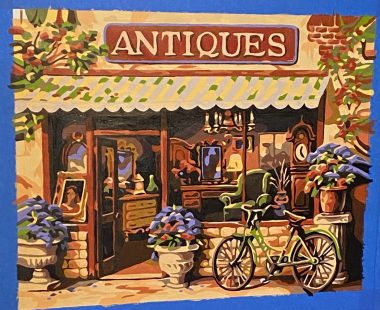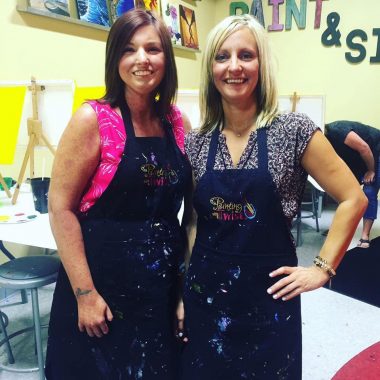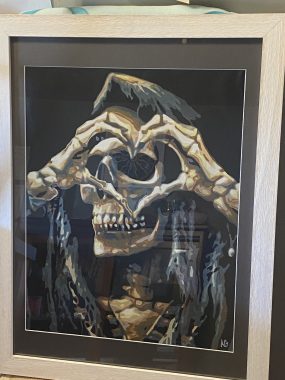Art Is My Outlet for Coping With Scleroderma
Written by |

When I was diagnosed with scleroderma at 19, it was dumped into my lap. The doctor simply looked at me and said, “Get your affairs in order and work as long as you can. Scleroderma has no cure and will ultimately take your life.”
To say I was affected mentally by this news would be the understatement of the century. I felt so confused and alone. I folded myself into my car, holding tightly the slip of paper that had “scleroderma” written on it in black ink, which the front office clerk had handed me as I left. I had no idea what scleroderma even was. How was I going to manage an illness when I didn’t know how I’d acquired it or how I could get rid of it?
As I reflect on the day my old life ended and my new life as a chronically ill patient began, I can see that I wasn’t mentally prepared for what would follow. I don’t think any scleroderma patient ever is.
How illness affects my mental health
My life as a patient has been a mashup of highs and lows. I’ve had moments when I felt out of control and terrified of my body, followed by moments when I felt capable of overcoming anything.
My life has felt like a battle of the fittest, mentally and physically. But scleroderma will always be the first to cross the finish line in every race, leaving me with a participatory ribbon and a pat on the back for effort.

Amy painted “Rustic Antique Shop” for a silent auction. The proceeds went to the Steffens Scleroderma Foundation. (Courtesy of Amy Gietzen)
Deny, deny, deny
Life with scleroderma was chaotic. It took everything I had to pick up the pieces of my shattered hopes and dreams and superglue them back together so I could function as an adult.
For years, I lived in denial of my disease and its emotional toll on me. I was too young to understand myself as a woman, let alone a woman with a potentially terminal illness. How could I heal my broken heart and pick up the pieces of my life when I wasn’t even old enough to drink a beer?
I looked completely normal on the outside. My makeup was perfect, my clothes were tidy, my appearance was as neat as a pin. But underneath, with scleroderma nipping at my heels, I was crying out, “Help! Can anybody out there hear me?”
My mantra had been, “If I ignore it, it’ll go away,” but I knew that front would only hold for so long. Ignoring my illness left me tearing at the walls of my subconscious, trying to find a way out of what I was feeling. I needed a lifeline that could rescue my emotional well-being.
And then, I rediscovered my love for art and painting.

Amy, left, takes an art class with her sister, Christine. (Courtesy of Amy Gietzen)
Painting rainbows of happiness helps
As a teen, I dabbled in painting, but it was never more than a hobby. After I got sick, I figured I had plenty of free time on my hands. Perhaps I could blow off steam by throwing paint on a canvas.
The start was rough, but my artwork got better, and painting became a healthy way for me to express my emotions — rather than blowing things up or lighting trash cans on fire. It has given me the freedom and creativity to express my anger, pain, and frustration. With swift strokes of a brush and the vivid colors of acrylic paint, I can skillfully combine bold designs and robust colors and shapes to create something spectacular. Painting allows me to work through my emotions, process my grief, and transform my fear and rage into something beautiful.
My family and friends have even started commissioning me to paint pieces for them. This hasn’t been about earning money, though. Expressing myself through art has greatly benefited my mental health.

Amy painted this image of the Grim Reaper for a friend. (Courtesy of Amy Gietzen)
Scleroderma will never just go away, and I’ll never be OK with having the disease. But I have made my peace with it, and art has helped me to get there. It’s a way to cope with the realities of my illness and expel my demons. Painting helps me to keep a cool head, and at the same time, gift the people I love with unique pieces of art to remember me by.
***
Note: Scleroderma News is strictly a news and information website about the disease. It does not provide medical advice, diagnosis, or treatment. This content is not intended to be a substitute for professional medical advice, diagnosis, or treatment. Always seek the advice of your physician or other qualified health provider with any questions you may have regarding a medical condition. Never disregard professional medical advice or delay in seeking it because of something you have read on this website. The opinions expressed in this column are not those of Scleroderma News or its parent company, Bionews, and are intended to spark discussion about issues pertaining to scleroderma.







Tracey Kenard
My disabled son is battling Scleroderma. I didn't know what was going on as the disease attacked his body. Sadly, he never complains so I have no idea what he feels from minute to minute. I often wonder what he thinks of the changes in his appearance and body. He's one of the most positive, happy folks on the planet so he keeps me upbeat when I worry. Your artwork is AMAZING!! I'm glad you found a way to 'heal.' :-)
Betty Taylor
Hang in there Amy. I was diagnosed with systemic sclerosis / scleroderma / raynauds / sjogrens the full blow thing. I can identify with everything say - the highs and lows - good days and bad days. I'm 81 now, still ticking along and have regular hospital visits as I have lung, heart, liver, kidney, issues that need frequent checks all caused by scleroderma. My feet are painful from scleroderma and my is thinning from the drugs but I'm still breathing. Sorry about all this moaning - what I wanted to say is, that art was my saviour too. I no longer attend my art classes but I still work from home doing my art and writing a blog and joining in an online writers' group. Keep going. Sending you good wishes. xxx
Tory Cary
Your work is magnificent. I have just gone back to clay work and am thankful for it. It’s fun and feels so good to be creative. Thank you for your post!
Dan Pacillas
Touching story.. Your art work is excellent. I see the toll the disease takes on my wife every day. The smile I see in your Photo and the smiles my wife displays brings joy to the ones around us. Keep up the fight and enjoy the good moments.
hoping and praying for medical breakthroughs.
Mary Vale.
This story sounds very familiar. I have been battling this disease sine 1986. I am now 77 and still having a hard time with it.
Mary Vale
Lori Janes
Thank you for writing this article. I can really relate to it - when I was diagnosed at 31 (now 65) I had no idea what scleroderma was either. My doctor told me to read everything I could about it. There was nothing online then and I read an article in People magazine that said life expectancy was 14 years. That was a big blow which turned out to not be very accurate. I am not an artist like you but I have always done crafts. I had to give up knitting, crochet and stained glass due to sore hands but I found scrapbooking and it helps me stay busy and positive. I wish you all the best in the future.
LEAH KEITZ
Thank you for the inspiration. When I was firsst diagnosed four years ago as a result of kidney failure I thought my life was over. When my life threatening condition improved thanks to wonderful medical team I decided to pick up my paints and dabble in watercolor. I am a retired interior designer and was enjoying my life playing golf and spending time with friends around a card table. This ended and with the added threat of Covid, I have been a prisoner in my own body as well as my home. I put down my paint brushes because i couldn't find the inspiration to keep it up but having read your story I am again going to use whatever creativity I have to paint again. Thank you.